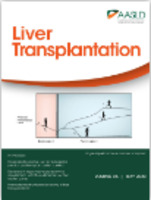Repositorio Digital
Direct-Acting Antivirals and Hepatocellular Carcinoma: No Evidence of Higher Wait-List Progression or Posttransplant Recurrence
- DSpace Principal
- →
- Hospital El Cruce
- →
- Publicaciones
- →
- Artículos
- →
- Ver ítem
JavaScript is disabled for your browser. Some features of this site may not work without it.
Direct-Acting Antivirals and Hepatocellular Carcinoma: No Evidence of Higher Wait-List Progression or Posttransplant Recurrence
Piñero, Federico; Boin, Ilka; Chagas, Aline; Quiñonez, Emilio; Marciano, Sebastián; Vilatobá, Mario; Santos, Luisa; Anders, Margarita; Hoyos Duque, Sergio; Soares Lima, Agnaldo; Menendez, Josemaría; Padilla, Martín; Poniachik, Jaime; Zapata, Rodrigo; Maraschio, Martín; Chong Menéndez, Ricardo; Muñoz, Linda; Arufe, Diego; Figueroa, Rodrigo; Mendizabal, Manuel; Hurtado Gomez, Sahara; Stucchi, Raquel; Maccali, Claudia; Vergara Sandoval, Rodrigo; Bermudez, Carla; McCormack, Lucas; Varón, Adriana; Gadano, Adrián; Mattera, Juan; Rubinstein, Fernando; Carrilho, Flair; Silva, Marcelo
URI:
https://doi.org/10.1002/lt.25744
http://repositorio.hospitalelcruce.org/xmlui/handle/123456789/1086
http://repositorio.hospitalelcruce.org/xmlui/handle/123456789/1086
Fecha:
2020-05
Resumen:
The association between direct-acting antivirals (DAAs) and hepatocellular carcinoma
(HCC) wait-list progression or its recurrence following liver transplantation (LT)
remains uncertain. We evaluated the impact of DAAs on HCC wait-list progression and
post-LT recurrence. This Latin American multicenter retrospective cohort study
included HCC patients listed for LT between 2012 and 2018. Patients were grouped
according to etiology of liver disease: hepatitis C virus (HCV) negative, HCV+ never
treated with DAAs, and HCV+ treated with DAAs either before or after
transplantation. Multivariate competing risks models were conducted for both HCC
wait-list progression adjusted by a propensity score matching (pre-LT DAA effect)
and for post-LT HCC recurrence (pre- or post-LT DAA effect). From 994 included
patients, 50.6% were HCV-, 32.9% were HCV+ never treated with DAAs, and 16.5% were
HCV+ treated with DAAs either before (n = 66) or after LT (n = 98). Patients treated
with DAAs before LT presented similar cumulative incidence of wait-list tumor
progression when compared with those patients who were HCV+ without DAAs (26.2%
versus 26.9%; P = 0.47) and a similar HCC-related dropout rate (12.1% [95% CI,
0.4%-8.1%] versus 12.9% [95% CI, 3.8%-27.2%]), adjusted for baseline tumor burden,
alpha-fetoprotein values, HCC diagnosis after listing, bridging therapies, and by
the probability of having received or not received DAAs through propensity score
matching (subhazard ratio [SHR], 0.9; 95% CI, 0.6-1.6; P = 0.95). A lower incidence
of posttransplant HCC recurrence among HCV+ patients who were treated with pre- or
post-LT DAAs was observed (SHR, 0.7%; 95% CI, 0.2%-4.0%). However, this effect was
confounded by the time to DAA initiation after LT. In conclusion, in this
multicenter cohort, HCV treatment with DAAs did not appear to be associated with an
increased wait-list tumor progression and HCC recurrence after LT.
Descripción:
Ficheros en el ítem
Nombre:
Captura de pantalla ...
Tamaño:
19.77Kb
Formato:
imagen PNG
Descripción:
Articulo en inglés
Este ítem aparece en la(s) siguiente(s) colección(ones)
-
Artículos
Articles
Buscar
Listar
-
Todo DSpace
-
Esta colección

